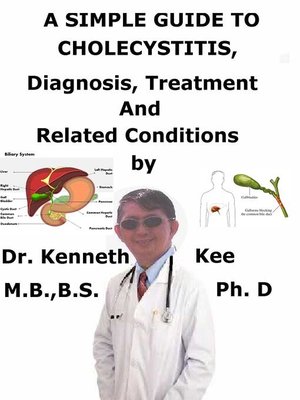
Sign up to save your library
With an OverDrive account, you can save your favorite libraries for at-a-glance information about availability. Find out more about OverDrive accounts.
Find this title in Libby, the library reading app by OverDrive.



Search for a digital library with this title
Title found at these libraries:
| Library Name | Distance |
|---|---|
| Loading... |
This book describes Cholecystitis, Diagnosis and Treatment and Related Diseases
Cholecystitis is a medical disorder produced by acute or chronic inflammation of the gallbladder.
Acute cholecystitis is an acute inflammation of the gallbladder that causes severe abdominal pain.
Acute cholecystitis happens when bile becomes trapped in the gallbladder.
Accumulation of trapped bile produces inflammation and pressure in the gallbladder.
This can result in infection and a hole (perforation) in the gallbladder.
In 95% of cases, acute cholecystitis is induced by gallstones in the gallbladder.
Other causes are severe illness and (rarely) tumors of the gallbladder.
Chronic cholecystitis induces inflammation and swelling of the gallbladder that persists over time.
Calculous cholecystitis is the most frequent and normally less serious type of acute cholecystitis.
It is responsible for around 95% of all cases.
Calculous cholecystitis occurs when the main opening to the gallbladder, called the cystic duct, becomes blocked by a gallstone or by a substance known as biliary sludge.
Biliary sludge is a combination of bile (produced by the liver that digests fats) and small crystals of cholesterol and salt.
The blockage in the cystic duct leads from a build-up of bile in the gallbladder, raising the pressure inside it and causing it to become inflamed.
In 20% cases, the inflamed gallbladder may also become infected by bacteria.
Acalculous cholecystitis is a less frequent but normally more serious form of acute cholecystitis.
It normally forms as a complication of a serious illness, infection or injury that damages the gallbladder.
Acalculous cholecystitis is often linked with problems such as accidental injury to the gallbladder during major surgery, blood poisoning (sepsis), serious damages or burns, severe malnutrition or AIDS.
Acute Cholecystitis is normally produced by these:
1. Blockage of the cystic duct by a gallstone -most common cause 95%
2. Bacterial infection after obstruction in 50% of cases
3. Bacterial or viral infection after gastroenteritis-germs from the intestines going up the cystic duct into gallbladder.
Chronic cholecystitis is normally caused by repeated attacks of acute cholecystitis.
These attacks produce the walls of the gallbladder to thicken.
The gallbladder starts to shrink.
After a period of time, the gallbladder is less capable of concentrating, storing, and releasing bile.
The major symptom is pain in the upper right quadrant or upper middle portion of the abdomen.
1. Slow start of abdominal pain starting from the epigastrium, spreading to the right sub costal area, may be palpated in the back at the sub-scapular region that normally persists at least 30 minutes.
The pain linked with acute cholecystitis is normally persistent, and does not go away within a few hours.
2. Nausea and vomiting
3. Loss of appetite
Diagnosis can normally be made by:
1. Physical examination with a positive Murphy's sign.
The affected upper right part of the abdomen is normally extremely tender, and breathing deeply can make the pain worse.
2. Plain X-rays can show the presence of gallstones in 10-15% patients
3. Oral cholecystogram is 95% accurate
4. Ultrasound is highly reliable in showing up the presence of gallstones
Even though cholecystitis may clear with medical treatment, surgery to remove the gallbladder (Cholecystectomy) is normally needed when gallstones are present.
TABLE OF CONTENT
Introduction
Chapter 1 Cholecystitis
Chapter 2 Causes







